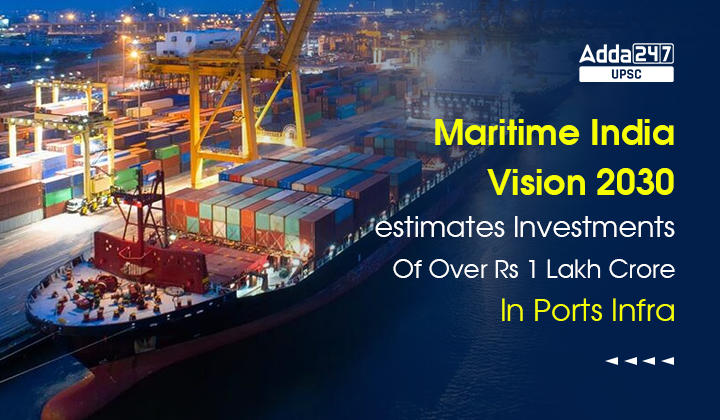Table of Contents
Maritime India Vision 2030: Maritime India Vision is a Plan of Ministry of Ports, Shipping and Waterways that aims to build port and maritime infrastructure within the country. Maritime India Vision 2030 is also important for UPSC Prelims 2023 and UPSC Mains Exam (GS Paper 3- Infrastructure: Energy, Ports, Roads, Airports, Railways etc.)
Maritime India Vision 2030 in News
Recently, the Union Minister for Ports, Shipping and Waterways, Shri Sarbananda Sonowal in a written reply to the Rajya Sabha informed about Maritime India Vision (MIV) 2030. The Maritime India Vision estimates investments of Rs. 1,00,000–1,25,000 crore for capacity augmentation and development of world-class infrastructure at Indian Ports.
Capacity of India’s Maritime Sector
The container throughput of Indian ports stood at 17 million TEUs for the period 2020 whereas that for China stood at 245 million TEUs for the same period. The combined container throughput across top 20 major global ports stood at 357 million TEUs during the period 2020.
- At present, India is not having landside mega-port and terminal infrastructure to deal with Ultra-large container ships.
- Ports need higher draft, several large cranes, better yard management capability, increased automation, larger storage facilities, more inland connectivity and enhanced labour productivity.
- Ultra-large container ships seek speedy unloading of the large volumes they carry.
Initiatives under Maritime India Vision (MIV) 2030
To develop global standard ports in India, Maritime India Vision (MIV) 2030 has identified initiatives such as developing world-class Mega Ports, transhipment hubs and infrastructure modernization of ports.
- It estimates the investments to the tune of INR 1,00,000–1,25,000 crore for capacity augmentation and development of world-class infrastructure at Indian Ports.
- The upcoming ports at Vizhinjam (Kerala) and Vadhavan (Maharashtra) have natural drafts in excess of 18m.
- This would enable ultra large container and cargo vessels to call on the ports thereby boosting the efforts to make India the world’s factory by improving the container and cargo throughput.
- A number of initiatives have been taken in India to promote green ecosystem in maritime sector.
- These are in line with International Maritime Organization (IMO)’s 2030 Decarbonization strategy and 2050 Green House Gases (GHG) strategy.
Major and Minor Ports in India
Maritime India Vision (MIV) 2030
Maritime India Vision 2030 was formulated by the Ministry of Ports, Shipping and Waterways with the objective of propelling India to the forefront of the global maritime sector in the next decade.
- Planned Initiatives: Over 150 initiatives covering 515 key activities across 10 themes encompassing all the facets of maritime sector have been identified to form the building blocks for future of the Indian Maritime sector.
- Investment: MIV 2030 envisions an overall investment of INR 3,00,000 – 3,50,000 Cr across ports, shipping, and inland waterways categories.
- This Investment amount excludes projects already under implementation stage as part of Sagarmala project.
- Significance: Maritime India vision roadmap is estimated to help unlock INR 20,000+ Cr worth of potential annual revenue for Indian Ports.
- Further, it is expected to create an additional 20 lakh jobs (direct and non-direct) in the Indian maritime sector.
Tariff guidelines for PPP projects in Major Ports
About Sagarmala programme
The Sagarmala Programme was approved in 2015 to promote port-led development in the country. Sagarmala project was launched by the ministry of Shipping to harness India’s 7,500 km long coastline, 14,500 km of potentially navigable waterways and strategic location on key international maritime trade routes.
- The main vision of the Sagarmala Programme is to reduce logistics cost for EXIM (Export-Import) and domestic trade with minimal infrastructure investment.
Green energy initiatives by major ports in India
- Increase share of renewable energy to more than 60% across major ports by 2030,
- setting up of solar power plants,
- availing of shore power supply to vessels via berths,
- multi-clean fuel adoption for vehicles within port ecosystem,
- gradual phasing out of diesel locomotives at ports, etc.
Maritime India Vision 2030 FAQs
1. What is Maritime India Vision 2030?
Ans. Maritime India Vision 2030 is a government roadmap for propelling India to the forefront of the global maritime sector in the next decade.
2. Which government initiative supersedes the Sagarmala Scheme?
Ans. Maritime India Vision 2030 is expected to supersede the Sagarmala Scheme.
3. What is the total investment planned under Maritime India Vision 2030?
Ans. Maritime India Vision 2030 envisions an overall investment of INR 3,00,000 – 3,50,000 Cr across ports, shipping, and in-land waterways categories.
Seven Years of Sagarmala Programme



 TSPSC Group 1 Question Paper 2024, Downl...
TSPSC Group 1 Question Paper 2024, Downl...
 TSPSC Group 1 Answer key 2024 Out, Downl...
TSPSC Group 1 Answer key 2024 Out, Downl...
 UPSC Prelims 2024 Question Paper, Downlo...
UPSC Prelims 2024 Question Paper, Downlo...




